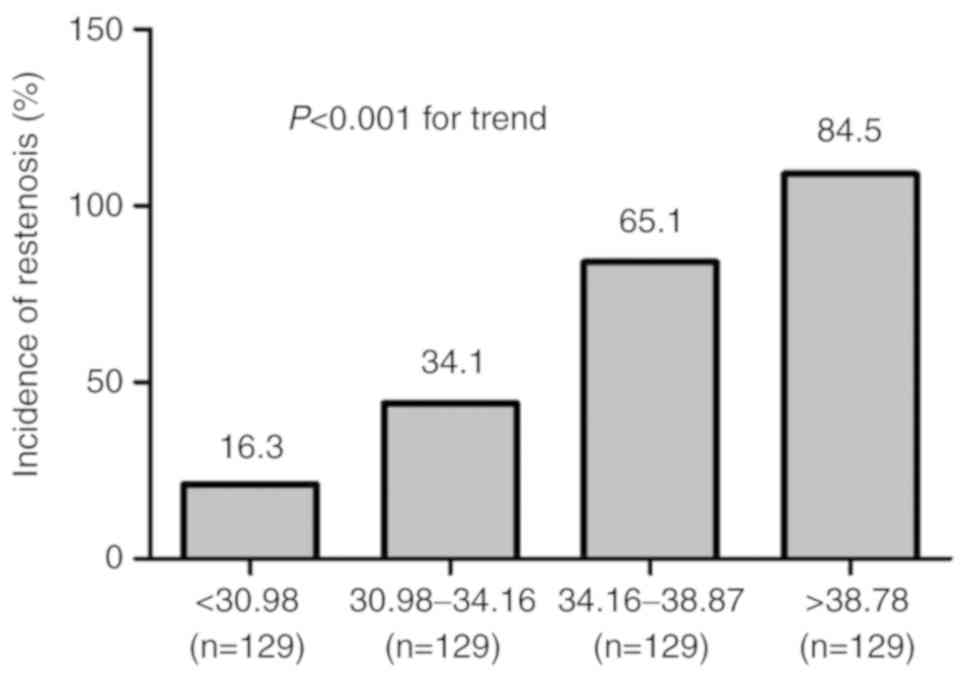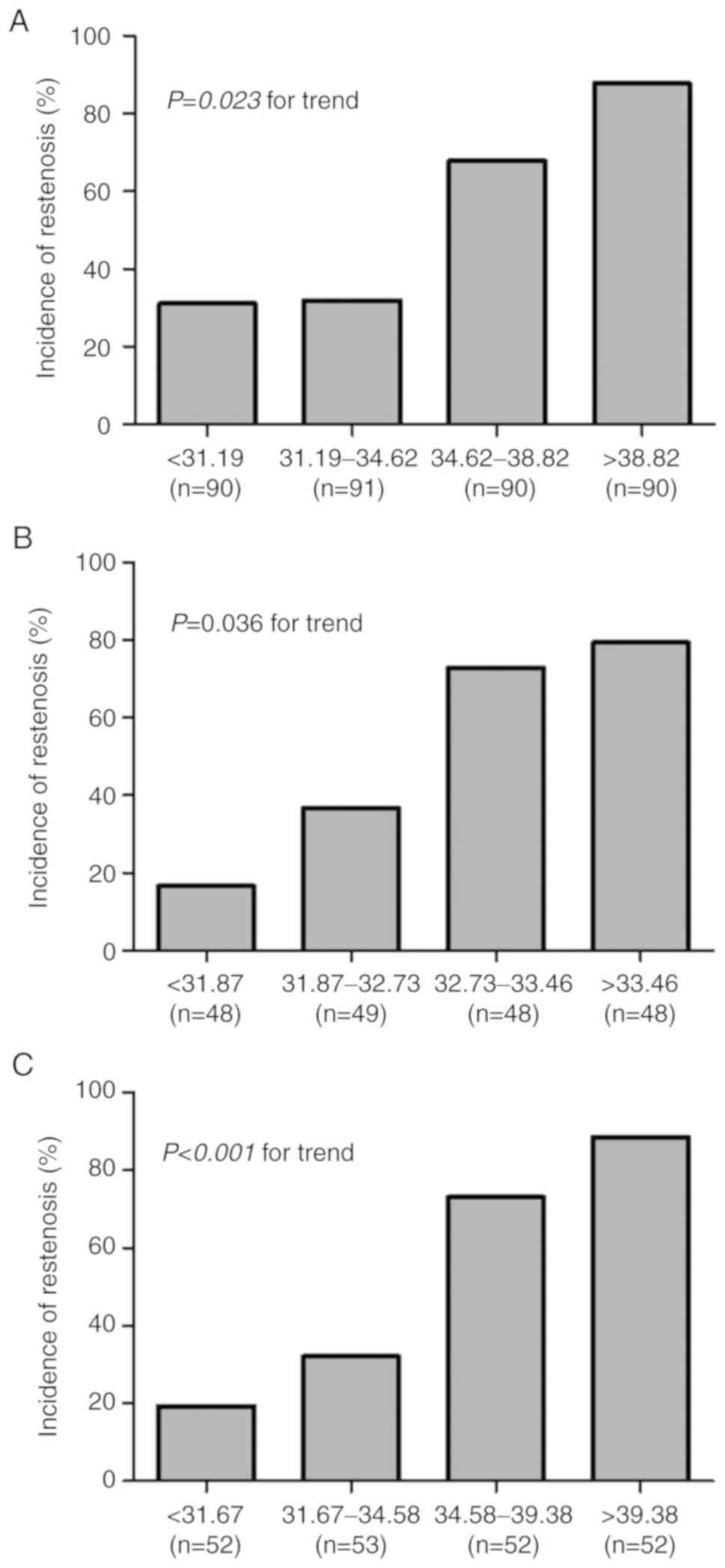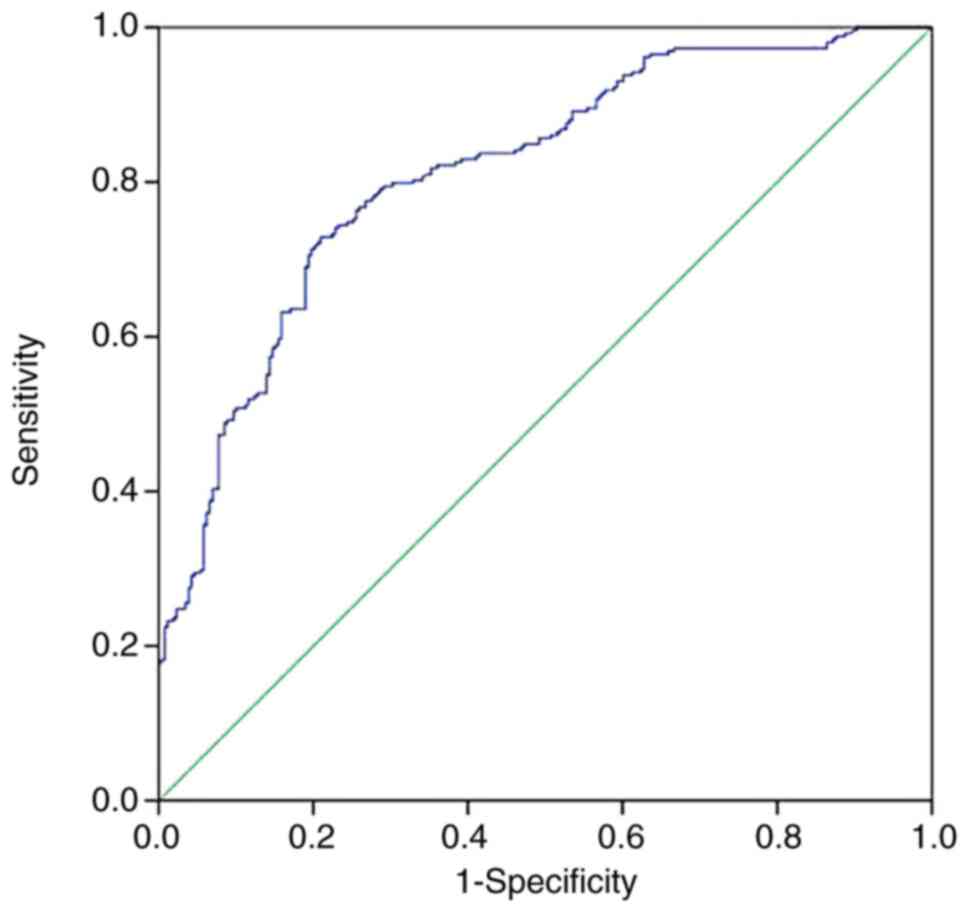|
1
|
Bague N, Nasr B, Chaillou P, Costargent A,
Gouailler-Vulcain F and Goueffic Y: The role for DCBs in the
treatment of ISR. J Cardiovasc Surg (Torino). 57:578–585.
2016.PubMed/NCBI
|
|
2
|
Kang IS, Shehata I, Shin DH, Kim JS, Kim
BK, Ko YG, Choi D, Jang Y and Hong MK: Comparison between
drug-coated balloon angioplasty and second-generation drug-eluting
stent placement for the treatment of in-stent restenosis after
drug-eluting stent implantation. Heart Vessels. 31:1405–1411.
2016.PubMed/NCBI View Article : Google Scholar
|
|
3
|
Baumann F, Willenberg T, Do DD, Keo HH,
Baumgartner I and Diehm N: Endovascular revascularization of
below-the-knee arteries: Prospective short-term angiographic and
clinical follow-up. J Vasc Interv Radiol. 22:1665–1673.
2011.PubMed/NCBI View Article : Google Scholar
|
|
4
|
He YH, Wang XQ, Zhang J, Liu ZH, Pan WQ,
Shen Y, Zhu ZB, Wang LJ, Yan XX, Yang K, et al: Association of
serum HMGB2 levels with in-stent restenosis: HMGB2 promotes
neointimal hyperplasia in mice with femoral artery injury and
proliferation and migration of VSMCs. Arterioscler Thromb Vasc
Biol. 37:717–729. 2017.PubMed/NCBI View Article : Google Scholar
|
|
5
|
Montone RA, Sabato V, Sgueglia GA and
Niccoli G: Inflammatory mechanisms of adverse reactions to
drug-eluting stents. Curr Vasc Pharmacol. 11:392–398.
2013.PubMed/NCBI View Article : Google Scholar
|
|
6
|
Wang Z, Zhang T, Sun L, Li R, Wei Y, Fan
X, Yuan Z, Liu J and Chen T: Pioglitazone attenuates drug-eluting
stent-induced proinflammatory state in patients by blocking
ubiquitination of PPAR. PPAR Res. 2016(7407153)2016.PubMed/NCBI View Article : Google Scholar
|
|
7
|
Foell D, Wittkowski H, Vogl T and Roth J:
S100 proteins expressed in phagocytes: A novel group of
damage-associated molecular pattern molecules. J Leukoc Biol.
81:28–37. 2007.PubMed/NCBI View Article : Google Scholar
|
|
8
|
Farokhzadian J, Mangolian Shahrbabaki P
and Bagheri V: S100A12-CD36 axis: A novel player in the
pathogenesis of atherosclerosis? Cytokine.
122(154104)2019.PubMed/NCBI View Article : Google Scholar
|
|
9
|
Bagheri V: S100A12: Friend or foe in
pulmonary tuberculosis? Cytokine. 92:80–82. 2017.PubMed/NCBI View Article : Google Scholar
|
|
10
|
Han EC, Cho SB, Ahn KJ, Oh SH, Kim J, Kim
DS, Lee KH and Bang D: Expression of pro-inflammatory protein
S100A12 (EN-RAGE) in behcet's disease and its association with
disease activity: A pilot study. Ann Dermatol. 23:313–320.
2011.PubMed/NCBI View Article : Google Scholar
|
|
11
|
Oesterle A and Bowman MA: S100A12 and the
S100/calgranulins: Emerging biomarkers for atherosclerosis and
possibly therapeutic targets. Arterioscler Thromb Vasc Boil.
35:2496–2507. 2015.PubMed/NCBI View Article : Google Scholar
|
|
12
|
Leach ST, Yang Z, Messina I, Song C, Geczy
CL, Cunningham AM and Day AS: Serum and mucosal S100 proteins,
calprotectin (S100A8/S100A9) and S100A12, are elevated at diagnosis
in children with inflammatory bowel disease. Scand J Gastroenterol.
42:1321–1331. 2007.PubMed/NCBI View Article : Google Scholar
|
|
13
|
Yan WX, Armishaw C, Goyette J, Yang Z, Cai
H, Alewood P and Geczy CL: Mast cell and monocyte recruitment by
S100A12 and its hinge domain. J Biol Chem. 283:13035–13043.
2008.PubMed/NCBI View Article : Google Scholar
|
|
14
|
Hofmann Bowman MA, Gawdzik J, Bukhari U,
Husain AN, Toth PT, Kim G, Earley J and McNally EM: S100A12 in
vascular smooth muscle accelerates vascular calcification in
apolipoprotein E-null mice by activating an osteogenic gene
regulatory program. Arterioscler Thromb Vasc Biol. 31:337–344.
2011.PubMed/NCBI View Article : Google Scholar
|
|
15
|
Burke AP, Kolodgie FD, Zieske A, Fowler
DR, Weber DK, Varghese PJ, Farb A and Virmani R: Morphologic
findings of coronary atherosclerotic plaques in diabetics: A
postmortem study. Arterioscler Thromb Vasc Boil. 24:1266–1271.
2004.PubMed/NCBI View Article : Google Scholar
|
|
16
|
Mahajan N, Malik N, Bahl A and Dhawan V:
Receptor for advanced glycation end products (RAGE) and its
inflammatory ligand EN-RAGE in non-diabetic subjects with
pre-mature coronary artery disease. Atherosclerosis. 207:597–602.
2009.PubMed/NCBI View Article : Google Scholar
|
|
17
|
Ligthart S, Sedaghat S, Ikram MA, Hofman
A, Franco OH and Dehghan A: EN-RAGE: A novel inflammatory marker
for incident coronary heart disease. Arterioscler Thromb Vasc Biol.
34:2695–2699. 2014.PubMed/NCBI View Article : Google Scholar
|
|
18
|
Saito T, Hojo Y, Ogoyama Y, Hirose M,
Ikemoto T, Katsuki T, Shimada K and Kario K: S100A12 as a marker to
predict cardiovascular events in patients with chronic coronary
artery disease. Circ J. 76:2647–2652. 2012.PubMed/NCBI View Article : Google Scholar
|
|
19
|
Williams B, Mancia G, Spiering W, Rosei
EA, Azizi M, Burnier M, Clement DL, Coca A, de Simone G, Dominiczak
A, et al: 2018 ESC/ESH guidelines for the management of arterial
hypertension. Kardiol Pol. 77:71–159. 2019.PubMed/NCBI View Article : Google Scholar : (In Polish).
|
|
20
|
Introduction: Standards of medical care in
diabetes-2019. Diabetes Care. 42 (Suppl 1):S1–S2. 2019.PubMed/NCBI View Article : Google Scholar
|
|
21
|
National Cholesterol Education Program
(NCEP) Expert Panel on Detection Evaluation and Treatment of High
Blood Cholesterol in Adults (Adult Treatment Panel III). Third
Report of the National cholesterol education program (NCEP) expert
panel on detection, evaluation, and treatment of high blood
cholesterol in adults (Adult Treatment Panel III) final report.
Circulation. 106:3143–3421. 2002.PubMed/NCBI
|
|
22
|
Schillinger M, Exner M, Mlekusch W,
Rumpold H, Ahmadi R, Sabeti S, Haumer M, Wagner O and Minar E:
Vascular inflammation and percutaneous transluminal angioplasty of
the femoropopliteal artery: Association with restenosis. Radiology.
225:21–26. 2002.PubMed/NCBI View Article : Google Scholar
|
|
23
|
Buyukterzi Z, Can U, Alpaydin S, Guzelant
A, Karaarslan S, Kocyigit D and Gurses KM: Enhanced S100A9 and
S100A12 expression in acute coronary syndrome. Biomark Med.
11:229–237. 2017.PubMed/NCBI View Article : Google Scholar
|
|
24
|
Zhao P, Wu M, Yu H, Huang Y, Wang Y, Wang
W and Yin W: Serum S100A12 levels are correlated with the presence
and severity of coronary artery disease in patients with type 2
diabetes mellitus. J Investig Med. 61:861–866. 2013.PubMed/NCBI View Article : Google Scholar
|
|
25
|
Schillinger M, Exner M, Mlekusch W, Haumer
M, Rumpold H, Ahmadi R, Sabeti S, Wagner O and Minar E:
Endovascular revascularization below the knee: 6-month results and
predictive value of C-reactive protein level. Radiology.
227:419–425. 2003.PubMed/NCBI View Article : Google Scholar
|
|
26
|
Rosenberg S, Elashoff MR, Beineke P,
Daniels SE, Wingrove JA, Tingley WG, Sager PT, Sehnert AJ, Yau M,
Kraus WE, et al: Multicenter validation of the diagnostic accuracy
of a blood-based gene expression test for assessing obstructive
coronary artery disease in nondiabetic patients. Ann Intern Med.
153:425–434. 2010.PubMed/NCBI View Article : Google Scholar
|
|
27
|
Liu J, Ren YG, Zhang LH, Tong YW and Kang
L: Serum S100A12 concentrations are correlated with angiographic
coronary lesion complexity in patients with coronary artery
disease. Scand J Clin Lab Investig. 74:149–154. 2014.PubMed/NCBI View Article : Google Scholar
|
|
28
|
Li H and Sun B: Toll-like receptor 4 in
atherosclerosis. J Cell Mol Med. 11:88–95. 2007.PubMed/NCBI View Article : Google Scholar
|
|
29
|
Hofmann MA, Drury S, Fu C, Qu W, Taguchi
A, Lu Y, Avila C, Kambham N, Bierhaus A, Nawroth P, et al: RAGE
mediates a novel proinflammatory axis: A central cell surface
receptor for S100/calgranulin polypeptides. Cell. 97:889–901.
1999.PubMed/NCBI View Article : Google Scholar
|
|
30
|
Rahel BM, Visseren FL, Suttorp MJ, Plokker
TH, Kelder JC, de Jongh BM, Bouter KP and Diepersloot RJ:
Preprocedural serum levels of acute-phase reactants and prognosis
after percutaneous coronary intervention. Cardiovasc Res.
60:136–140. 2003.PubMed/NCBI View Article : Google Scholar
|
|
31
|
Yang Z, Tao T, Raftery MJ, Youssef P, Di
Girolamo N and Geczy CL: Proinflammatory properties of the human
S100 protein S100A12. J Leukoc Biol. 69:986–994. 2001.PubMed/NCBI
|
|
32
|
Medina I, Cougoule C, Drechsler M,
Bermudez B, Koenen RR, Sluimer J, Wolfs I, Döring Y, Herias V,
Gijbels M, et al: Hck/Fgr kinase deficiency reduces plaque growth
and stability by blunting monocyte recruitment and intraplaque
motility. Circulation. 132:490–501. 2015.PubMed/NCBI View Article : Google Scholar
|
|
33
|
Gallo G, Pierelli G, Forte M, Coluccia R,
Volpe M and Rubattu S: Role of oxidative stress in the process of
vascular remodeling following coronary revascularization. Int J
Cardiol. 268:27–33. 2018.PubMed/NCBI View Article : Google Scholar
|
|
34
|
Tardif MR, Chapeton-Montes JA, Posvandzic
A, Page N, Gilbert C and Tessier PA: Secretion of S100A8, S100A9,
and S100A12 by neutrophils involves reactive oxygen species and
potassium efflux. J Immunol Res. 2015(296149)2015.PubMed/NCBI View Article : Google Scholar
|


















